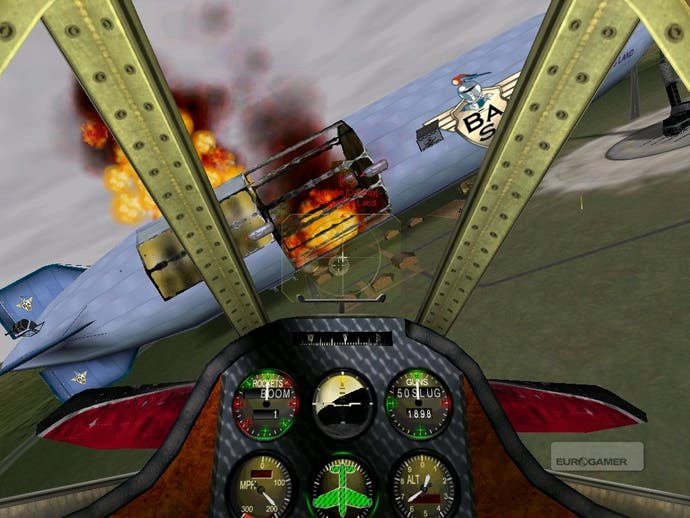Retrospective: Crimson Skies
Gorgeous planes and dangerous dames.
Trade secret: for the last 10 years, reviewing PC flight games has been a piece of cake. Step one - rabbit on about the fun-quotient, physics, visuals, missions and multiplayer for a bit. Step two - slip on the knuckledusters and deliver the kidney punch: "Of course, if you're after superlative sky thrills, you're still far better off with Crimson Skies."
One of the reasons why the likes of Blazing Angels, Secret Weapons Over Normandy, HAWX and Heroes Over Europe have never managed to topple this cloud-couched charmer is that none of them have half its character. Set in an alternate 1930s where gangs of air pirates prey on the giant zeppelins that have superseded ships and trains, the game has a freshness and coherence to its fiction that makes most World War II or modern backdrops seem ditchwater-dull. Zipper Interactive can't take all the credit for the shimmering lore. Much of the inspiration came direct from Jordan Weisman and Michael Stackpole's 1998 board-game, which in turn enthusiastically plundered the treasure chamber that is American pulp radio, cinema and literature.
The brilliant intro newsreel illustrates just how skilfully the developers mix history with hogwash. It also hints at another of the game's accomplishments - its characters. In a genre where the flying machines often seem to have more personality than the people piloting them, heroes like Nathan Zachary are worth their weight in hijacked Russian bullion.
He's the lead - an instantly likeable avatar that blends the roguish charm of Errol Flynn with the aeronautical prowess of Biggles and the sarcastic loot-lust of Indiana Jones. We get to know his wisecracking, warm, swashbuckly self primarily through cockpit banter and the wonderful audio that precedes missions.

Before every sortie, Nathan gathers his band of brigands (the Fortune Hunters) together in the mess of the Pandora (the squadron mothership) and explains the task ahead. The writing is so sharp, the hamminess of the voice acting so perfect during these high-spirited briefings-cum-pep-talks, it doesn't matter a jot that you can't actually see the slouching aviators. Their sly grins, resigned shrugs, and playful punches couldn't be any clearer.
By the time you clamber into your first virtual cockpit (still remarkably attractive all these years on), chances are you're already in love with the fantasy and deeply attached to the Fortune Hunters. If you've any interest in aviation history, once in the air this affection is sure to grow to encompass the aircraft themselves. The game's 11 types of flyable machinery blend fact with fiction in exactly the sort of intelligent, imaginative way the alternate history setting does.

It's as if Zipper's designers bought dozens of plastic kits of thirties and forties aircraft, mixed up all the bits, then got busy with the glue. There's the ungainly gull wings of a Corsair protruding from the barrel fuselage of a Hughes H-1 Racer. There's the twin tail of a Lightning attached to the fuselage of a Thunderbolt, and the front end of a Whirlwind fused to the back end of a Bf-110. Pusher propellers, canard wings, ventral vertical stabilisers... mixed and matched aeronautic exotica is everywhere.
How these weird warbirds would behave in the air is, of course, anybody's guess, but the imagined flight models have enough truth in them to be challenging and plausible. Though there's no complex engine management or vicious spins, occasionally you're still going to find yourself misjudging dives and wishing you hadn't slapped on quite so much armour during the last workshop session.







